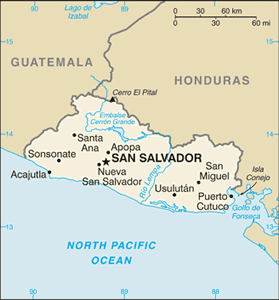The Geography of El Salvador
The Geography of El Salvador
Salvadoran Geography
Location: Central America, bordering the North Pacific Ocean, between Guatemala and Honduras
Geographic coordinates: 13 50 N, 88 55 W
Map references: Central America and the Caribbean
Area: total: 21,040 sq km land: 20,720 sq km water: 320 sq km
Area - comparative: slightly smaller than Massachusetts
Land boundaries: total: 545 km border countries: Guatemala 203 km, Honduras 342 km
Coastline: 307 km
Maritime claims: territorial sea: 12 nm contiguous zone: 24 nm exclusive economic zone: 200 nm
Climate: tropical; rainy season (May to October); dry season (November to April); tropical on coast; temperate in uplands
Terrain: mostly mountains with narrow coastal belt and central plateau
Elevation extremes: lowest point: Pacific Ocean 0 m highest point: Cerro El Pital 2,730 m
Natural resources: hydropower, geothermal power, petroleum, arable land
Land use: arable land: 31.37% permanent crops: 11.88% other: 56.75% (2005)
Irrigated land: 450 sq km (2003)
Natural hazards: known as the Land of Volcanoes; frequent and sometimes destructive earthquakes and volcanic activity; extremely susceptible to hurricanes
Environment - current issues: deforestation; soil erosion; water pollution; contamination of soils from disposal of toxic wastes
Environment - international agreements: party to: Biodiversity, Climate Change, Climate Change-Kyoto Protocol, Desertification, Endangered Species, Hazardous Wastes, Ozone Layer Protection, Wetlands signed, but not ratified: Law of the Sea
Geography - note: smallest Central American country and only one without a coastline on Caribbean Sea


